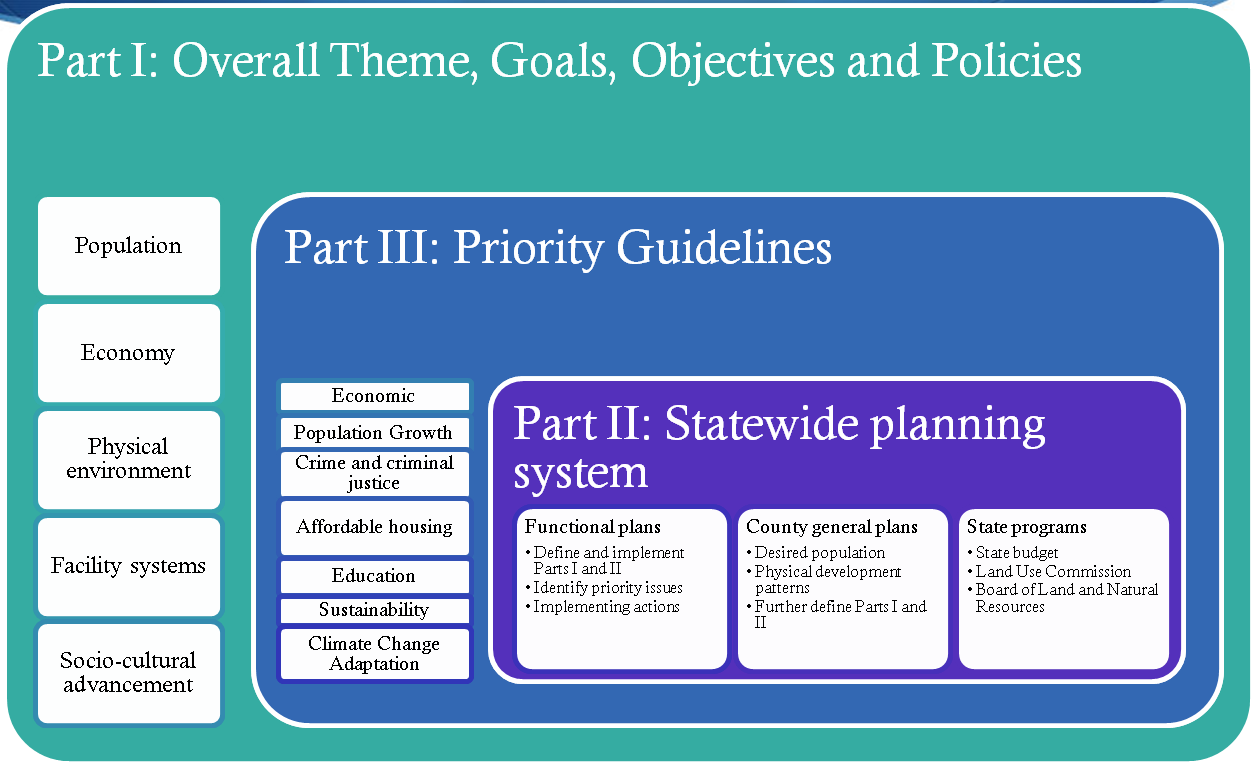Hawaii State Planning Act
All state agencies, including the Office of Planning, are guided by the Hawaii State Planning Act, which is a broad policy document that sets the table for all activities, programs, and decisions made by local and state agencies.
The Hawaii State Planning Act was signed into law in 1978 to “improve the planning process in this state, to increase the effectiveness of government and private actions, to improve coordination among different agencies and levels of government, to provide for wise use of Hawaii’s resources and to guide the future development of the state” (HRS § 226-1). The Act is codified under HRS Chapter 226.
The Act sets forth the Hawaii state plan, which is a long-range comprehensive plan that includes an overall theme, goals, objectives, policies, priority guidelines, and implementation mechanisms. The Hawaii state plan:
- Serves as a guide for the future long-range development of the state
- Identifies the goals, objectives, policies, and priorities for the state
- Provides a basis for determining priorities and allocating limited resources, such as public funds, services, human resources, land, energy, water, and other resources
- Improves coordination of federal, state, and county plans, policies, programs, projects, and regulatory activities
- Establishes a system for plan formulation and program coordination to provide for an integration of all major state, and county activities
State Plan and Statewide Planning System
The state plan is divided into three parts, as follows:
Part I, Overall Theme, Goals, Objectives, and Policies. Part I lists the state plan’s overall theme and goals. Objectives and policies are listed in sections 226-5 through 226-27. Objectives and policies focus on general topic areas, including population, economy, physical environment, facility systems, and socio-cultural advancement.
Part II, Planning Coordination and Implementation. Part II of the state plan establishes a statewide planning system to coordinate and guide all major state and county activities and to implement the overall theme, goals, objectives, policies, and priority guidelines. The system implements the state plan through the development of functional plans and county general plans. Functional plans, general plans, and the formulation, administration, and implementation of state programs must be in conformance with the state plan (HRS § 226-59).
Functional plans set forth the policies, statewide guidelines, and priorities within a specific field of activity, when such activity or program is proposed, administered, or funded by any agency of the state. Functional plans are developed by the state agency primarily responsible for a given functional area, which include agriculture, conservation lands, education, energy, higher education, health, historic preservation, housing, recreation, tourism, and transportation. When preparing functional plans, the agency responsible must seek the cooperation of advisory committees established by the governor (HRS § 226-55(c)), affected government officials, and people from each county. Functional plans must identify priority issues in the functional area and contain objectives, policies, and implementing actions to address those priority issues. Actions may include organizational or management initiatives, facility or physical infrastructure development initiatives, initiatives for programs and services, or legislative proposals. Functional plans are approved by the governor and serve as guidelines for funding and implementation by state and county agencies. In addition, functional plans shall be used to guide the allocation of resources for the implementation of state policies adopted by the legislature (HRS § 226-57).
County general plans are comprehensive long-range plans, which have been adopted by ordinance or resolution by a county council. General plans are formulated with input from the state and county agencies as well as the general public (HRS § 226-58). County general plans must include the following information and considerations:
- Indicate desired population and physical development patterns for each county and regions within each county
- Address the unique problems and needs of each county and regions within each county
- Define applicable provisions of the state plan
- Consider statewide objectives, policies, and programs stipulated in approved state functional plans
- Use sound rationale, data, analyses, and input from state and county agencies and the general public
- Contain objectives to be achieved and policies to be pursued with respect to population density, land use, transportation system location, public and community facility locations, water and sewage system locations, visitor destinations, urban design, and all other matters necessary for the coordinated development of the county and regions within the county
- Contain implementation priorities and actions to carry out policies to include but not be limited to land use maps, programs, projects, regulatory measures, standards and principles, and interagency coordination provisions
Part III, Priority Guidelines. The purpose of this part is to establish overall priority guidelines to address areas of statewide concern (HRS § 226-101). This part lays out the overall direction for the state, as follows: “The state shall strive to improve the quality of life for Hawaii’s present and future population through the pursuit of desirable courses of action in five major areas of statewide concern which merit priority attention: economic development, population growth and land resource management, affordable housing, crime and criminal justice, and quality education” (HRS § 226-102).
The Office of Planning’s Role
The Office of Planning’s role with regard to the Hawaii State Planning Act is laid out in HRS § 226-53. Generally, the Office provides technical assistance in administering the Act, and may contract with public and private agencies and persons for special research and planning assistance. Among other things, the Office is specifically tasked with the following:
- Providing recommendations to the governor and state and county agencies on conflicts between the state plan, state functional plans, county general plans and development plans, and state programs
- Reviewing and evaluating this the Hawaii State Planning Act and recommending amendments as needed to the legislature
- Reviewing major plans, programs, projects, and regulatory activities proposed by state and county agencies, and provide advisory opinions and reports to the governor as needed
- Analyzing existing state policies, planning and program operations, laws, rules, and practices relative to formulation, implementation, and coordination of the state plan
- Reviewing state capital improvement projects for consistency with this chapter and reporting findings and recommendations to the governor prior to allocation of funds
- Conducting strategic planning by identifying and analyzing significant issues, problems, and opportunities confronting the state, and formulating strategies and alternative courses of action in response to identified problems and opportunities
- Conducting special studies and preparing reports that address major policy issues relating to statewide growth and development
- Cooperating with all public agencies to ensure an ongoing, uniform, and reliable base of data and projections
- Assisting the legislature in conducting reviews of parts I, II, and III of the Hawaii State Planning Act as necessary
- Providing other technical assistance to the governor and state and county agencies as needed
- Preparing a report identifying emerging issues for use in the revision of parts I and III of the Hawaii State Planning Act, including the updating of state functional plans

